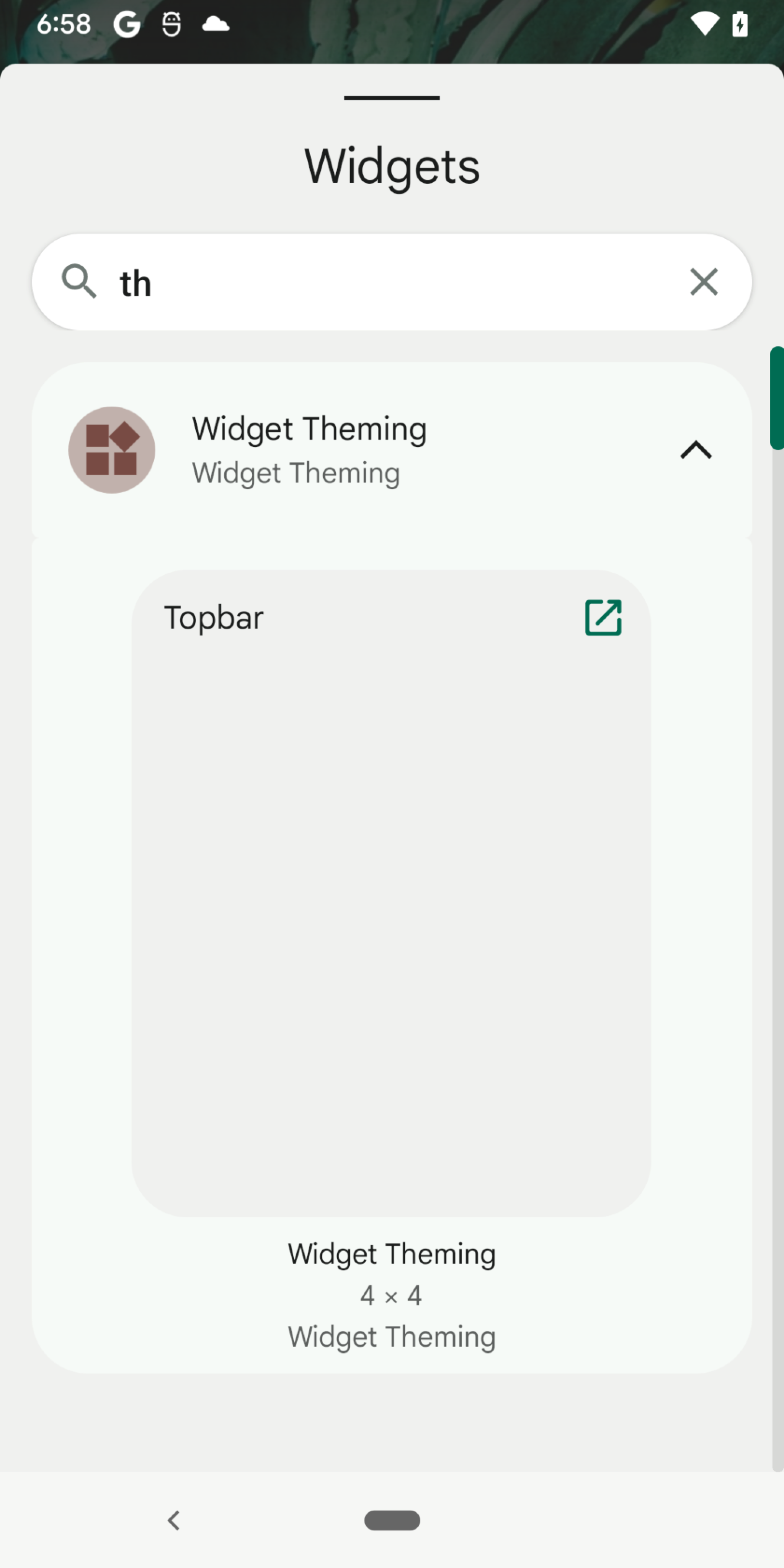產生的動態小工具預覽畫面可準確反映小工具在使用者主畫面上的顯示方式,這些預覽畫面是透過推送 API 提供,也就是說,應用程式會在生命週期內的任何時間提供預覽畫面,不必接收來自小工具主機的明確要求。
如要提升應用程式的小工具選擇器體驗,請在 Android 15 以上版本裝置上提供產生的小工具預覽畫面,在 Android 12 至 Android 14 裝置上提供縮放的小工具預覽畫面 (方法是指定 previewLayout),並在舊版裝置上提供 previewImage。
詳情請參閱 YouTube 上的「Enrich your app with live updates and widgets」。
設定應用程式,以預覽生成的小工具
如要在搭載 Android 15 以上版本的裝置上顯示產生的動態小工具預覽畫面,請先在模組 build.gradle 檔案中將 compileSdk 值設為 35 以上,以便向小工具挑選器提供 RemoteViews。
應用程式隨後可以在 GlanceAppWidgetManager 或 AppWidgetManager 中使用 setWidgetPreview。為防止濫用行為並減輕系統健康問題,setWidgetPreview 是設有頻率限制的 API。預設限制為每小時約兩通電話。
使用 Jetpack Glance 生成更新的預覽畫面
如果是使用 Jetpack Glance 建構的小工具,請按照下列步驟操作:
覆寫
GlanceAppWidget.providePreview函式,為預覽畫面提供可組合內容。如要在provideGlance中載入應用程式資料並傳遞至小工具的內容可組合函式,請確保預覽畫面顯示正確資料。與provideGlance不同,這是單一組合,不會重組或產生任何效果。呼叫
GlanceAppWidgetManager.setWidgetPreviews即可產生及發布預覽畫面。
系統不會提供預覽畫面,因此應用程式必須決定何時呼叫 setWidgetPreviews。更新策略取決於小工具的用途:
- 如果小工具含有靜態資訊或快速操作,請在首次啟動應用程式時設定預覽畫面。
- 應用程式有資料後,即可設定預覽畫面,例如使用者登入或完成初始設定後。
- 您可以設定定期工作,以所選頻率更新預覽畫面。
排解生成的預覽畫面問題
常見的問題是,生成預覽畫面後,預覽圖片可能會缺少圖片、圖示或其他可組合函式,相較於小工具的放置大小。這個放置大小是由 targetCellWidth 和 targetCellHeight (如有指定) 定義,或是由應用程式小工具供應商資訊檔案中的 minWidth 和 minHeight 定義。
這是因為 Android 預設只會轉譯小工具最小尺寸可見的可組合函式。換句話說,Android 會預設將 previewSizeMode 設為 SizeMode.Single。系統會使用android:minHeight和android:minWidth應用程式小工具供應器資訊 XML,判斷要繪製哪些可組合函式。
如要修正這個問題,請在 GlanceAppWidget 中覆寫 previewSizeMode,並將其設為 SizeMode.Responsive,提供一組 DpSize 值。這會告知 Android 預覽畫面需要的所有版面配置大小,確保所有元素都能正確顯示。
針對特定板型規格進行最佳化。從最小值開始,並按照小工具的中斷點,提供 1 或 2 個大小。至少指定一張圖片 以確保回溯相容性。如要瞭解不同格線大小適用的最小 DP 值,請參閱小工具設計指南。
產生不含 Jetpack Glance 的更新預覽畫面
即使沒有微光模式,你也能使用 RemoteViews。以下範例會載入 XML 小工具版面配置資源,並設為預覽畫面。如要讓 setWidgetPreview 在這個程式碼片段中顯示為方法,compileSdk 建構設定必須為 35 以上。
AppWidgetManager.getInstance(appContext).setWidgetPreview(
ComponentName(
appContext,
ExampleAppWidgetReceiver::class.java
),
AppWidgetProviderInfo.WIDGET_CATEGORY_HOME_SCREEN,
RemoteViews("com.example", R.layout.widget_preview)
)
在小工具挑選器中新增可縮放的小工具預覽畫面
從 Android 12 開始,小工具挑選器中顯示的小工具預覽畫面可縮放。您提供的 XML 版面配置會設為小工具的預設大小。先前,小工具預覽畫面是靜態可繪資源,在某些情況下,預覽畫面會無法準確反映小工具新增至主畫面時的顯示方式。
如要實作可縮放的小工具預覽畫面,請使用 appwidget-provider 元素的 previewLayout 屬性,改為提供 XML 版面配置:
<appwidget-provider
android:previewLayout="@layout/my_widget_preview">
</appwidget-provider>
建議您使用與實際小工具相同的版面配置,並提供實際的預設值或測試值。大多數應用程式都使用相同的 previewLayout 和 initialLayout。如需建立準確預覽版面配置的指引,請參閱本頁的下一節。
建議您同時指定 previewLayout 和 previewImage 屬性,這樣一來,如果使用者的裝置不支援 previewLayout,應用程式就能改用 previewImage。previewLayout 屬性的優先順序高於 previewImage 屬性。
小工具預覽的回溯相容性
如要讓 Android 11 (API 級別 30) 以下版本的動態小工具選擇器顯示動態小工具的預覽畫面,或是做為產生的預覽畫面的備援,請指定 previewImage 屬性。
如果變更小工具的外觀,請更新預覽圖片。
建立包含動態項目的準確預覽畫面

本節說明在具有集合檢視區塊的小工具 (即使用 ListView、GridView 或 StackView 的小工具) 的小工具預覽畫面中顯示多個項目的建議做法。這不適用於產生的動態小工具預覽畫面。
如果小工具使用其中一個檢視區塊,直接提供實際小工具版面配置來建立可縮放的預覽畫面,會導致小工具預覽畫面未顯示任何項目時,使用者體驗不佳。這是因為集合檢視區塊資料是在執行階段動態設定,看起來與圖 1 所示的圖片類似。
如要讓小工具預覽畫面在小工具挑選器中正確顯示,建議您維護專為預覽畫面設計的獨立版面配置檔案。這個獨立的版面配置檔案應包含下列項目:
- 實際的小工具版面配置。
- 含有虛擬項目的預留位置集合檢視畫面。舉例來說,您可以提供含有多個虛假清單項目的預留位置
LinearLayout,模擬ListView。
如要說明 ListView 的範例,請先從獨立版面配置檔案開始:
// res/layout/widget_preview.xml
<LinearLayout xmlns:android="http://schemas.android.com/apk/res/android"
android:layout_width="match_parent"
android:layout_height="wrap_content"
android:background="@drawable/widget_background"
android:orientation="vertical">
// Include the actual widget layout that contains ListView.
<include
layout="@layout/widget_view"
android:layout_width="match_parent"
android:layout_height="wrap_content" />
// The number of fake items you include depends on the values you provide
// for minHeight or targetCellHeight in the AppWidgetProviderInfo
// definition.
<TextView android:text="@string/fake_item1"
android:layout_width="match_parent"
android:layout_height="wrap_content"
android:layout_marginVertical="?attr/appWidgetInternalPadding" />
<TextView android:text="@string/fake_item2"
android:layout_width="match_parent"
android:layout_height="wrap_content"
android:layout_marginVertical="?attr/appWidgetInternalPadding" />
</LinearLayout>
提供 AppWidgetProviderInfo 中繼資料的 previewLayout 屬性時,請指定預覽版面配置檔案。您仍須為 initialLayout 屬性指定實際的小工具版面配置,並在執行階段建構 RemoteViews 時使用實際的小工具版面配置。
<appwidget-provider
previewLayout="@layout/widget_previe"
initialLayout="@layout/widget_view" />
複雜的清單項目
上一節的範例提供的是虛擬清單項目,因為清單項目是 TextView 物件。如果項目是複雜的版面配置,提供虛擬項目可能會更加複雜。
假設 widget_list_item.xml 中定義的清單項目包含兩個 TextView 物件:
<LinearLayout xmlns:android="http://schemas.android.com/apk/res/android"
android:layout_width="match_parent"
android:layout_height="wrap_content">
<TextView android:id="@id/title"
android:layout_width="match_parent"
android:layout_height="wrap_content"
android:text="@string/fake_title" />
<TextView android:id="@id/content"
android:layout_width="match_parent"
android:layout_height="wrap_content"
android:text="@string/fake_content" />
</LinearLayout>
如要提供虛假清單項目,您可以多次加入版面配置,但這會導致每個清單項目都相同。如要提供不重複的清單項目,請按照下列步驟操作:
為文字值建立一組屬性:
<resources> <attr name="widgetTitle" format="string" /> <attr name="widgetContent" format="string" /> </resources>使用下列屬性設定文字:
<LinearLayout xmlns:android="http://schemas.android.com/apk/res/android" android:layout_width="match_parent" android:layout_height="wrap_content"> <TextView android:id="@id/title" android:layout_width="match_parent" android:layout_height="wrap_content" android:text="?widgetTitle" /> <TextView android:id="@id/content" android:layout_width="match_parent" android:layout_height="wrap_content" android:text="?widgetContent" /> </LinearLayout>視需要建立多種樣式,以供預覽。重新定義每個樣式中的值:
<resources> <style name="Theme.Widget.ListItem"> <item name="widgetTitle"></item> <item name="widgetContent"></item> </style> <style name="Theme.Widget.ListItem.Preview1"> <item name="widgetTitle">Fake Title 1</item> <item name="widgetContent">Fake content 1</item> </style> <style name="Theme.Widget.ListItem.Preview2"> <item name="widgetTitle">Fake title 2</item> <item name="widgetContent">Fake content 2</item> </style> </resources>在預覽版面配置中,對虛擬項目套用樣式:
<LinearLayout xmlns:android="http://schemas.android.com/apk/res/android" android:layout_width="match_parent" android:layout_height="wrap_content" ...> <include layout="@layout/widget_view" ... /> <include layout="@layout/widget_list_item" android:theme="@style/Theme.Widget.ListItem.Preview1" /> <include layout="@layout/widget_list_item" android:theme="@style/Theme.Widget.ListItem.Preview2" /> </LinearLayout>

